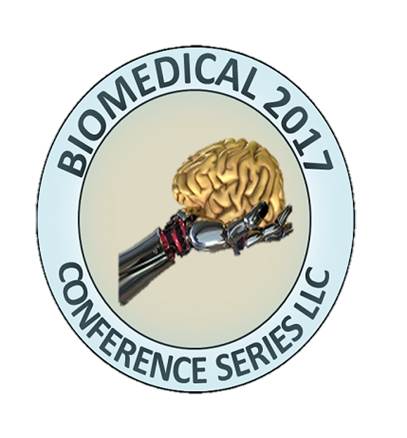
Bryan J McEntire
University of Utah, USA
Title: Bacteriostatic behavior of silicon nitride, polyether ether ketone and titanium biomaterials
Biography
Biography: Bryan J McEntire
Abstract
Statement of the Problem: Perioperative and latent infections (PJI) are leading causes of revision surgery for orthopedic devices. They are a growing problem due to the rising antibiotic resistance of bacteria to germicidal therapies. An in vitro test was developed to compare biofilm formation on three biomaterials, polyether ether ketone (PEEK), a titanium alloy (Ti6Al4V-ELI) and a series of surface-modulated silicon nitride (Si3N4) bioceramics using Gram-positive Staphylococcus epidermidis (S. epidermidis) and Gram-negative Escherichia coli (E. coli).
Methods: Several variants of Si3N4 (Amedica Corp., Salt Lake City, UT, USA), PEEK (ASTM D6262) and Ti-alloy (ASTM F136) discs (Ø12.7 mm × 1 mm) were characterized, cleaned, UV sterilized and exposed to 105 bacteria cultures of either S. epidermidis (ATCC 14990) or E. coli (ATCC 25922) for 24 and 48 hours. They were then vortexed, plated and incubated at 37 oC for 24-48 hours, followed by comparative bacterial colony counting.
Results: The two bacterial biofilm tests are presented in Figure 1 and 2 for S. epidermidis and E. coli, respectively. A two-tailed, heteroscedastic student’s t-test (95% confidence) was used to determine statistical significance. The highest density of CFUs was always found on the PEEK biomaterial, followed by the Ti-alloy and then the various Si3N4substrates. Biofilm growth on PEEK was between 2-3 orders of magnitude greater than on the Ti-alloy or any of the Si3N4 materials (all p<0.005). Ti6Al4V also had more bacteria than the Si3N4 samples, but it was not significant in all cases.
Conclusion: Development of bacteriostatic biomaterials is one of many important prosthetic device strategies to combat PJI. Si3N4 shows considerable promise in its inherent ability to inhibit bacterial attachment and biofilm formation and as a result, it represents a significant advancement over traditional biomaterials.
Discussion: Attachment of bacteria to biomaterial surfaces is complex and correlations to single parameters are often difficult to assess. A multivariate approach is necessary because microbial adhesion is not only related to the bacterial strain itself, but also affected by the biomaterial’s surface topography, charging, wetting behavior, chemistry and the in vivo environment (e.g., serum proteins, nutrients and fluid-flow conditions). In each of these categories, the various Si3N4 materials examined within this study appear to have appropriate surface and chemical characteristics to inhibit biofilm establishment, including sub-micron and nanoscale topography, improved wetting, large negative surface charge and elutable functional moieties.

